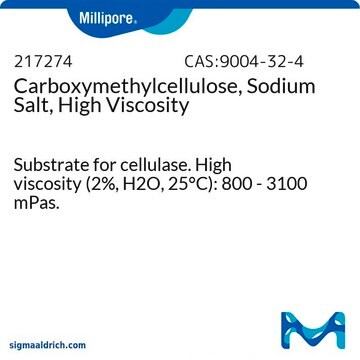419303
Sodium carboxymethyl cellulose
average Mw ~250,000, degree of substitution 0.9
Synonim(y):
Carboxymethylcellulose sodium salt
About This Item
Polecane produkty
Postać
powder
temp. samozapłonu
698 °F
masa cząsteczkowa
average Mw ~250,000
zakres etykietowania
0.9 carboxymethyl groups per anhydroglucose unit
mp
270 °C (dec.)
InChI
1S/C6H12O6.C2H4O2.Na/c7-1-3(9)5(11)6(12)4(10)2-8;1-2(3)4;/h1,3-6,8-12H,2H2;1H3,(H,3,4);
Klucz InChI
DPXJVFZANSGRMM-UHFFFAOYSA-N
Szukasz podobnych produktów? Odwiedź Przewodnik dotyczący porównywania produktów
Opis ogólny
Zastosowanie
- food processing, textiles
- detergents, and drugs
- a stabilizer in the preparation of nanoparticles
- a binder for the fabrication of electrodes
Kod klasy składowania
11 - Combustible Solids
Klasa zagrożenia wodnego (WGK)
WGK 1
Temperatura zapłonu (°F)
Not applicable
Temperatura zapłonu (°C)
Not applicable
Środki ochrony indywidualnej
Eyeshields, Gloves, type N95 (US)
Certyfikaty analizy (CoA)
Poszukaj Certyfikaty analizy (CoA), wpisując numer partii/serii produktów. Numery serii i partii można znaleźć na etykiecie produktu po słowach „seria” lub „partia”.
Masz już ten produkt?
Dokumenty związane z niedawno zakupionymi produktami zostały zamieszczone w Bibliotece dokumentów.
Klienci oglądali również te produkty
Nasz zespół naukowców ma doświadczenie we wszystkich obszarach badań, w tym w naukach przyrodniczych, materiałoznawstwie, syntezie chemicznej, chromatografii, analityce i wielu innych dziedzinach.
Skontaktuj się z zespołem ds. pomocy technicznej





